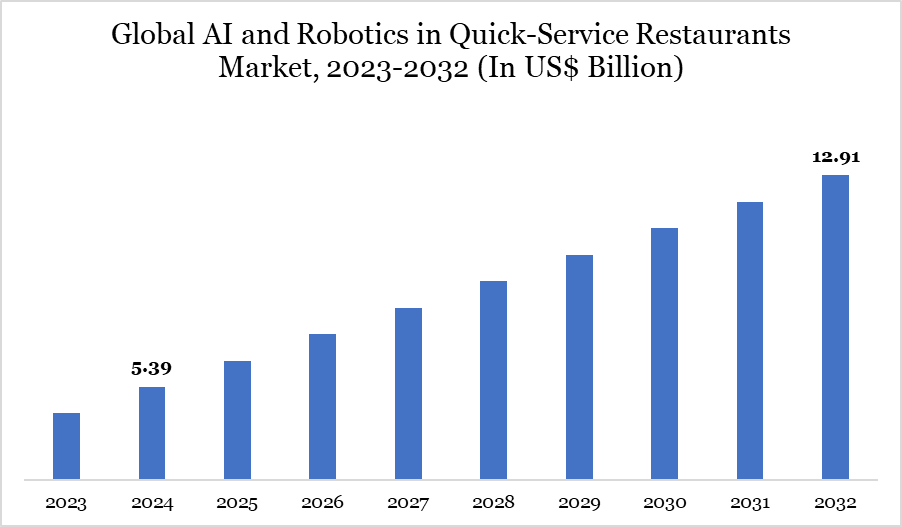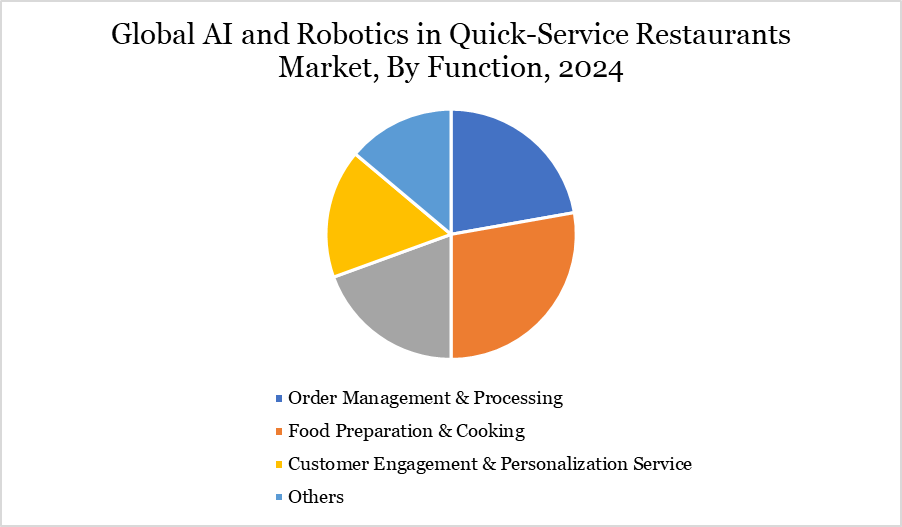Market Size
Global AI and Robotics in Quick-Service Restaurants Market reached US$ 5.39 billion in 2024 and is expected to reach US$ 12.91 billion by 2032, growing with a CAGR of 11.54% during the forecast period 2025-2032.
Artificial intelligence (AI) and robotics are increasingly transforming the quick-service restaurant (QSR) industry by enhancing operational efficiency and customer satisfaction. Major chains like McDonald's and Taco Bell are at the forefront of this technological shift. McDonald's is implementing AI across its 43,000 global locations to expedite service and improve experiences for both customers and employees. This includes AI-enabled drive-throughs and management tools designed to ensure order accuracy and predict equipment issues.
McD company partnered with Google Cloud in 2023 to facilitate faster, on-site data processing, aiming to reduce employee stress and increase its loyal customer base from 175 million to 250 million by 2027. The integration of AI and robotics in QSRs not only streamlines operations but also addresses labor shortages and rising wage issues.

For more details on this report, Request for Sample
Market Scope
| Metrics | Details |
| By Function | Order Management & Processing, Food Preparation & Cooking, Inventory & Supply Chain Management, Customer Engagement & Personalization, Others. |
| By Deployment Type | On-Premises, Cloud-Based AI |
| By Technology | AI based solutions, Robotic solutions |
| Report Insights Covered | Competitive Landscape Analysis, Company Profile Analysis, Market Size, Share, Growth |
Market Dynamics
Driver: Enhanced Operational Efficiency and Cost Reduction
The integration of artificial intelligence (AI) and robotics in quick-service restaurants (QSRs) significantly enhances operational efficiency and reduces costs. Robots can perform tasks faster than humans, leading to reduced waiting times and improved customer satisfaction. For instance, studies have shown that robotic assistance in restaurants can decrease service time, allowing human staff to focus on more complex tasks, thereby improving overall efficiency.
Additionally, robots can be programmed to collect and analyze real-time data, performing tasks in minutes that would take humans much longer to complete. This capability enhances inventory management, ensuring consistently stocked supplies and reducing waste.
Restraint: Employee Job Security Concerns
Despite the operational benefits, the adoption of AI and robotics in QSRs raises concerns about employee job security. Service employees' awareness of adopting and using service robots significantly impacts their perception of robot-induced unemployment.
This perception can lead to resistance to technological adoption, affecting employee morale and productivity. Furthermore, the potential dehumanization of service experiences due to robot implementation may impact customer satisfaction, posing additional challenges to the widespread adoption of AI and robotics in QSRs.
Market Segment Analysis
The global AI and robotics in quick-service restaurants market is segmented based on function, deployment type, technology and region.

Food Preparation & Cooking in the global market is expected to drive the market.
The Food Preparation & Cooking segment is expected to be a major driver of AI and robotics adoption in quick-service restaurants (QSRs) worldwide. Automated cooking systems and robotic food preparation technologies are being increasingly deployed to enhance efficiency, improve food consistency, and reduce operational costs. Studies indicate that AI-powered robotic chefs can reduce food preparation time by up to 50%, leading to faster service and improved customer experience.
Additionally, automation helps maintain food safety standards by minimizing human contact, which has become a priority post-pandemic. The U.S. Department of Agriculture (USDA) has emphasized the role of automation in food processing and handling, highlighting its potential to reduce waste and optimize ingredient usage. Governments worldwide are also investing in AI-driven food production innovations to enhance food security and address labor shortages in the restaurant industry. Japan, for example, has implemented AI-driven robotic kitchen solutions to counter labor shortages in the foodservice sector
Market Geographical Share
Rapid Technological Advancements in North America.
The demand for AI and robotics in the quick-service restaurants (QSR) market in North America is rapidly growing due to labor shortages, rising operational costs, and increasing consumer expectations for faster service. The U.S. Bureau of Labor Statistics (BLS) projects a continued decline in foodservice labor availability, with over 1 million job vacancies in hospitality and food services as of early 2024.
AI-driven automation helps fill this gap by improving efficiency, reducing reliance on human labor, and optimizing restaurant operations. The National Institute of Standards and Technology (NIST) highlights AI’s role in predictive maintenance for kitchen equipment, reducing downtime and enhancing productivity in QSRs. Robotics is also being integrated into food preparation, order processing, and customer service to meet growing demand for speed and consistency.
Sustainability Analysis
Implementing AI and robotics in QSRs contributes to sustainability by optimizing resource use, reducing waste, and enhancing energy efficiency. For instance, McDonald's has embarked on a global initiative to upgrade its 43,000 restaurants with AI-driven technologies aimed at improving operational efficiency and customer experience. These upgrades include internet-connected kitchen equipment and AI-enabled drive-through systems designed to streamline operations and minimize resource wastage.
Furthermore, AI's role in enhancing food safety cannot be overlooked. The U.S. Food and Drug Administration (FDA) has recognized the potential of AI in revolutionizing food safety protocols. AI applications can quickly analyze data to detect potential foodborne pathogens, ensuring safer food handling practices and reducing the risk of contamination.
Technology Analysis
The technological landscape of QSRs is rapidly evolving with the adoption of AI and robotics. McDonald's partnership with Google Cloud in 2023 exemplifies this shift, enabling edge computing capabilities across its restaurants. This technology allows for faster and more efficient data processing on-site, which is crucial for real-time applications like AI-powered drive-throughs and kitchen operations.
Robotics is making significant inroads into QSR kitchens. Companies like Miso Robotics have developed AI-driven robotic platforms, such as "Flippy," which can perform frying tasks in commercial kitchens. These robots are designed with extensive AI skill sets and machine learning capabilities, aiming to improve consistency and efficiency in food preparation.
The U.S. Bureau of Labor Statistics (BLS) projects that total employment will grow by 4.0 percent, adding 6.7 million jobs from 2023 to 2033. However, the retail trade sector, which includes QSRs, is the only sector projected to lose jobs over this period. This projection underscores the potential impact of automation and AI on employment within the industry, highlighting the need for workforce adaptation and upskilling.
Major Global Players
The major global players in the market include McDonald's Corporation, Yum! Brands (Taco Bell, KFC, Pizza Hut), Domino’s Pizza, Inc., Starbucks Corporation, Wendy’s Company, Burger King (Restaurant Brands International), Chipotle Mexican Grill, Inc., Panera Bread, White Castle, and CaliBurger.
Why Choose DataM?
- Data-Driven Insights: Dive into detailed analyses with granular insights such as pricing, market shares and value chain evaluations, enriched by interviews with industry leaders and disruptors.
- Post-Purchase Support and Expert Analyst Consultations: As a valued client, gain direct access to our expert analysts for personalized advice and strategic guidance, tailored to your specific needs and challenges.
- White Papers and Case Studies: Benefit quarterly from our in-depth studies related to your purchased titles, tailored to refine your operational and marketing strategies for maximum impact.
- Annual Updates on Purchased Reports: As an existing customer, enjoy the privilege of annual updates to your reports, ensuring you stay abreast of the latest market insights and technological advancements. Terms and conditions apply.
- Specialized Focus on Emerging Markets: DataM differentiates itself by delivering in-depth, specialized insights specifically for emerging markets, rather than offering generalized geographic overviews. This approach equips our clients with a nuanced understanding and actionable intelligence that are essential for navigating and succeeding in high-growth regions.
- Value of DataM Reports: Our reports offer specialized insights tailored to the latest trends and specific business inquiries. This personalized approach provides a deeper, strategic perspective, ensuring you receive the precise information necessary to make informed decisions. These insights complement and go beyond what is typically available in generic databases.
Target Audience 2024
- Manufacturers/ Buyers
- Industry Investors/Investment Bankers
- Research Professionals
- Emerging Companies
Suggestions for Related Report
- Global AI in Water Management Market
- Global AI in Agriculture Market
- Global Gen AI in Automotive Market

